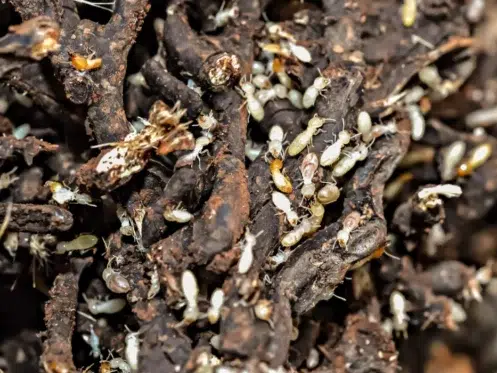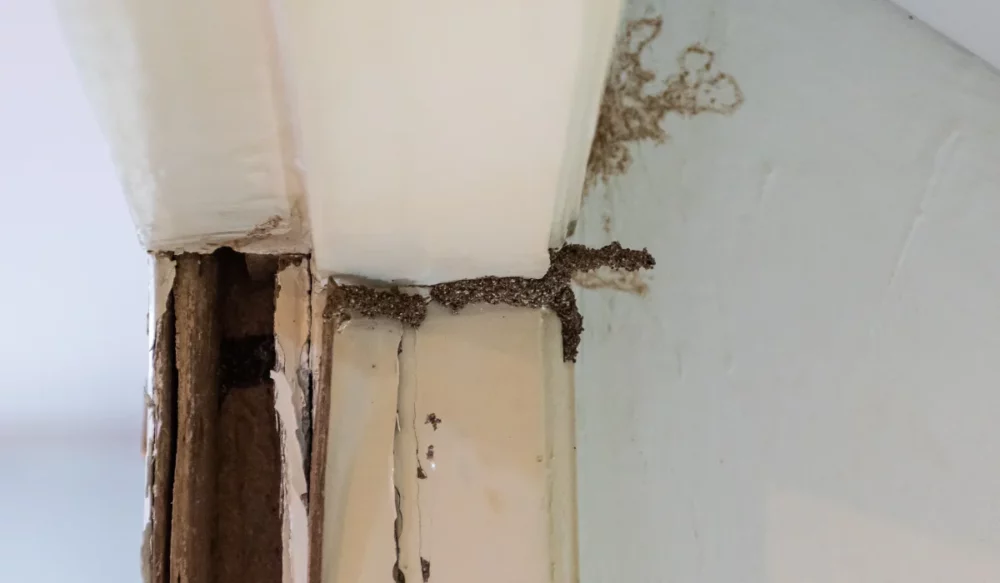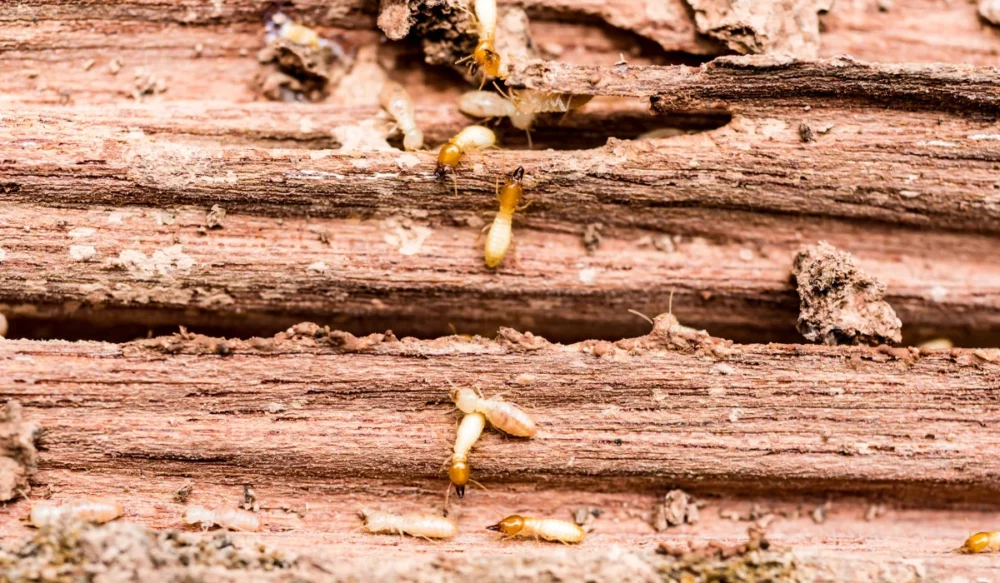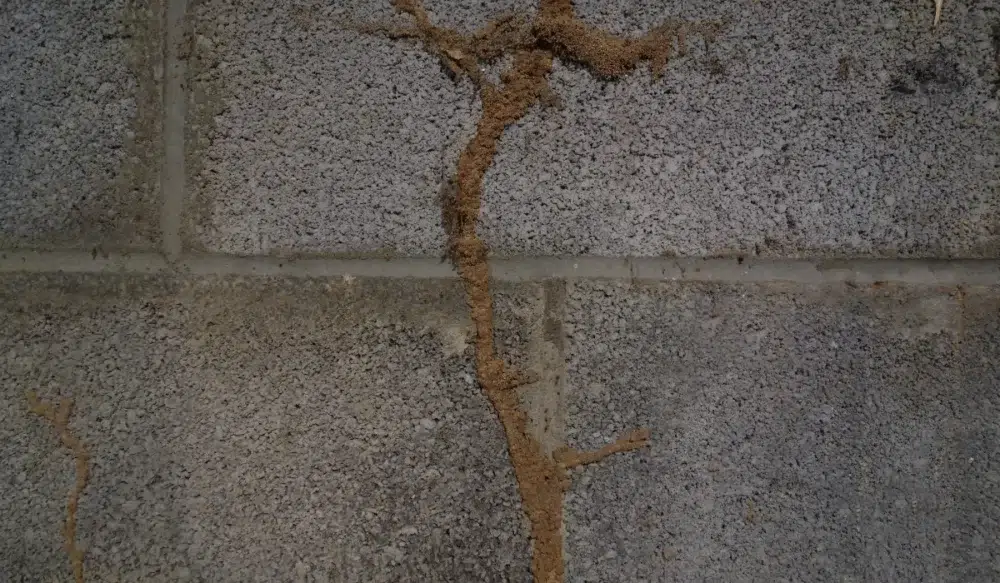In Arizona, subterranean termites stay active when temperatures drop. In the fall across Phoenix, Tucson, and Chandler, these destructive pests move deeper underground and toward your foundation to find warmth and moisture. Many homeowners miss the early signs, and colonies continue to grow until real damage becomes apparent.
Many people think termite season ends after summer, but termites remain active throughout the year. What changes is where they move. In the fall, they tunnel deeper into the soil and wood, out of sight, and keep eating the wood in your home. Be aware of these fall habits so you can prevent damage early and avoid costly repair bills.
This guide shows the top fall signs of subterranean termites in Arizona, common mistakes to avoid, and how professional help can keep your home protected.
Key Takeaways
- Subterranean termites stay active in the fall and often go unseen until damage shows.
- Look for mud tubes, uniform pellets called frass, and hollow-sounding wood.
- Schedule regular inspections. Professionals help find problems early and stop new ones.
- Green Home Pest Control provides safe and effective termite treatment and prevention services for homes in Arizona.
Understanding Subterranean Termite Activity in Fall
Subterranean termites in Arizona depend on soil moisture and mild temperatures, making fall one of their most active seasons underground. These termites build extensive mud tubes that connect their nests to wooden food sources inside and around homes.
Unlike drywood termites, which live entirely within wood, subterranean termites require contact with soil to survive. As the desert climate cools, they move closer to foundations, crawl spaces, and door frames where heat and moisture collect. The presence of these mud tubes is one of the first visible signs of termite activity around homes in Phoenix and Tucson.
Termite colonies can contain thousands of members working nonstop. Without intervention, they can cause structural damage that compromises a building’s stability.
Regular termite inspections help catch these problems before they lead to costly repairs, especially if you want to start getting rid of subterranean termites in Arizona before they cause lasting structural damage.
Fall Warning Signs Homeowners Often Overlook
Many Arizona homeowners confuse early signs of fall with regular seasonal changes. Spotting these small clues can prevent significant damage.
Mud Tubes Near the Foundation
Mud tubes are narrow, soil-like tunnels that termites build to travel between their colony and a wood source. They often appear along walls, pipes, or baseboards. If you break one open and see worker termites inside, it confirms an active infestation. These tubes help maintain moisture and protect the colony from dry Arizona air.
Hollow-Sounding Wood and Damaged Walls
When termites feed on wooden structures, they consume cellulose from the inside out, leaving a thin outer layer. Tap along your door frames, baseboards, or drywall. A hollow sound can signal damaged wood beneath the surface.
In Chandler homes, termite damage can manifest as blistered paint, sagging floors, or weakened beams, all of which compromise the home’s structural integrity.
Frass and Termite Droppings
Subterranean termites often leave waste in their tunnels, but you may still see frass near entry points. The pellets look like fine, uniform grains, not sawdust.
Swarmers and Discarded Wings
During Arizona’s mild fall days, reproductive termites, also called winged termites or swarmers, emerge from mature colonies to form new colonies. You may notice flying termites near light sources or find discarded wings on windowsills and floors. These indicate nearby termite colonies preparing to expand.
Why Subterranean Termites Are Arizona’s Silent Destroyers
Termites can eat wood for months before you notice any signs. They feed day and night on materials that contain cellulose, such as wood, paper, and drywall.
Homes in Phoenix and Chandler with wood framing or irrigated soil face a higher risk. Even small leaks or poor drainage can facilitate the spread of termites. The longer they feed unnoticed, the worse the damage becomes.
Understanding the difference between drywood vs. subterranean termites helps homeowners know where to look for signs of activity. Drywood termites live entirely in wood and are easier to spot, while subterranean termites hide beneath floors and foundations, often requiring professional inspection to locate active colonies.
Common Food Sources and Entry Points Around Homes
Subterranean termites need constant access to cellulose. Wooden fences, decks, and mulch make easy meals. From there, they build mud tubes toward your home’s foundation and slip in through tiny cracks or plumbing gaps.
Common entry points include crawl spaces, door frames, and baseboards. Even if your foundation is made of concrete, termites can still gain entry through joints or gaps near utility lines. If you spot any activity or damage, knowing what to do when you see termites in your Arizona home can help prevent a minor issue from turning into a costly infestation.
Early Detection Through Regular Inspections
Finding termites early is the best way to avoid significant damage. A professional inspection can detect termite activity before it causes damage to your home. Technicians look for mud tubes, hollow wood, and hidden signs in crawl spaces and attics.
DIY checks often miss the subtle clues. Store treatments rarely reach underground nests. Certified pest control experts utilize tools such as moisture meters and bait systems to locate and eliminate colonies.
At Green Home Pest Control, we offer free estimates and custom plans that target active colonies and prevent new infestations.
The Importance of Professional Termite Control in Phoenix Homes
Professional termite control in Phoenix, AZ, tackles the source of the problem and helps stop future activity. While termites mainly target wood, many homeowners wonder, “Are termites dangerous to humans?” They don’t bite or spread disease, but untreated infestations can weaken structures and create safety risks. We use organic, family-safe treatments that protect your home without harsh chemicals.
Plans may include targeted soil treatments and bait systems to eliminate active colonies and prevent the formation of new ones. Follow-up visits help maintain protection as seasons change.
In Scottsdale and Tucson, irrigation and lush landscaping add moisture to the soil. Regular professional monitoring detects termite activity promptly and helps homeowners avoid costly repairs.
Proactive Measures for Year-Round Termite Prevention
Start prevention by reducing access to food and moisture. Keep soil below the foundation line and repair leaky sprinklers or AC lines. Store firewood away from the house and keep mulch at least a few feet away from exterior walls.
Seal gaps around utility pipes and keep crawl spaces clean and dry. Homeowners often ask, “How often should you treat termites in Arizona?” The answer depends on your property’s risk level, but scheduling termite inspections in Phoenix, AZ, or surrounding areas every six to twelve months, especially after the monsoon season, is a smart rule of thumb.
Making the Right Termite Control Choice for Your Arizona Home
Even after summer ends, termite protection should stay on your list of home priorities. The key is consistency: keeping up with inspections, staying alert for new signs, and acting quickly if something appears amiss.
At Green Home Pest Control, we offer reliable, year-round termite solutions designed for Arizona’s unique soil and climate. Our experts utilize safe, proven methods that prevent hidden colonies from causing damage.
Ready to protect your home? Contact us today to schedule your termite inspection and keep your property strong through every season.
FAQs
What are the most common signs of subterranean termites in Arizona?
Look for mud tubes on walls or foundations, hollow-sounding wood, frass, and discarded wings from swarmers. These signs of termite activity indicate the presence of nearby colonies that require immediate attention.
How do subterranean termites differ from drywood termites?
Subterranean termites live underground and require soil contact to survive, while drywood termites live entirely inside wood. Subterranean termites often cause more structural damage because they remain hidden for an extended period.
How can I prevent termites from entering my home?
Repair water leaks, maintain proper drainage, keep wood structures dry, and schedule regular inspections to prevent damage. Professional termite control services in Phoenix can help identify and seal potential entry points for termites, providing adequate protection against these pests.




